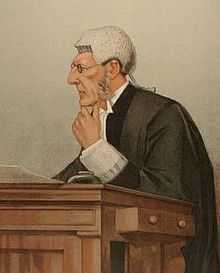Frederick Albert Bosanquet

Sir Frederick Albert Bosanquet, KC, JP (8 February 1837–2 November 1923) was the Common Serjeant of London, the second most senior permanent judge of the Central Criminal Court after the Recorder of London.
Frederick 'Bosey' Bosanquet was one of ten surviving children born to Samuel Richard Bosanquet, DL, JP (1800-1882), of Dingestow Court, Monmouthshire, the grandson of Samuel Bosanquet (1744-1806), Governor of the Bank of England from 1791 to 1793. The family were of Huguenot origin, the Bosanquets having fled to England from Lunel, Montpellier in France in 1685 following the revocation of the Edict of Nantes.[1] His mother, Emily Courthope (died 1869), was a descendant of the Plantaganets.[2]
Bosanquet was educated at Eton and at King's College, Cambridge, of which he was formerly a Fellow (BA 1860, MA 1863), and was called to the Bar at the Inner Temple in 1863. With George N. Darby he co-authored A Practical Treatise on the Statutes of Limitations in England and Ireland, his only published work, written in 1867.[3]
He was appointed a Q.C. in 1882, and elected a Bencher in 1889. He was a Magistrate for Monmouthshire and Sussex, and was Chairman of the East Sussex Quarter Sessions.[4]
He was the Recorder for Worcester from 1879 to 1891, and Recorder for Wolverhampton in 1891 and 1900. In 1900 he was appointed Common Serjeant of London, an ancient office first recorded in 1291 with the appointment of Thomas Juvenal, and the second most senior judicial position at the Old Bailey after the Recorder of London.[2] Bosanquet was the Chairman of the Incorporated Council of Law Reporting from 1907 to 1917.[4]
On 22 August 1871 Bosanquet married Albinia Mary C. Hayward, the daughter of John Curtis Hayward, and with whom he had four children. After her death, in 1885 he married Philippa Frances, the daughter of William Bence-Jones, with whom he had a son.[2]
As a barrister Bosanquet was based in chambers at 3 Paper Buildings, Temple from 1892.[5] He was knighted in 1907.
On his retirement as Common Serjeant in November 1917 he was succeeded by Henry Fielding Dickens KC.[6]
His son from his second marriage, Captain William Sidney Bence Bosanquet DSO (1893–1966), of the Coldstream Guards, married Esther Cleveland, the daughter of Grover Cleveland, a former President of the United States, on 14 March 1918 in Westminster Abbey.[7][8] One of their two children was the philosopher Philippa Foot.
References
- ↑ Records of the Bosanquet Family - Gwent Record Office
- ↑ 2.0 2.1 2.2 The Marquis of Ruvigny and Raineval, The Plantaganet Roll of the Blood Royal Heritage books, Inc (2001) pg 516 Google Books
- ↑ Darby, George N and Frederick Bosanquet A Practical Treatise on the Statutes of Limitations in England and Ireland London William Maxwell & Son, 29, Fleet Street [etc.] (1867)
- ↑ 4.0 4.1 Walford, Edward The County Families of the United Kingdom; or, Royal Manual of the Titled and Untitled Aristocracy of England, Wales, Scotland, and Ireland (Volume ed.59, yr.1919) pg 40 Google Books
- ↑ Bosanquet on the 3 Paper Buildings website
- ↑ Dickens, Henry Fielding 'The Recollections of Sir Henry Fielding Dickens, K.C.' Published by William Heinemann Ltd (1934) pg 276
- ↑ Esther Cleveland Weds Capt. Bosanquet: Late President's Daughter Marries Coldstream Guards Officer in Westminster Abbey The New York Times 15 March 1918
- ↑ William Sydney Bence Bosanquet on thepeerage.com